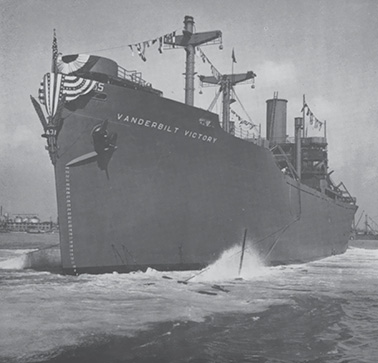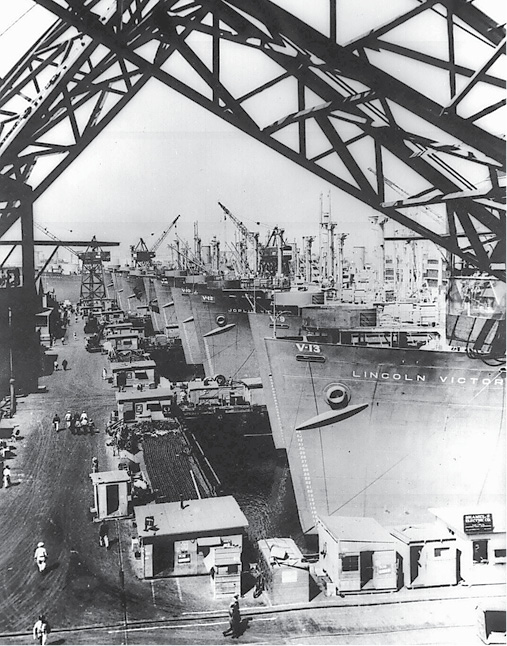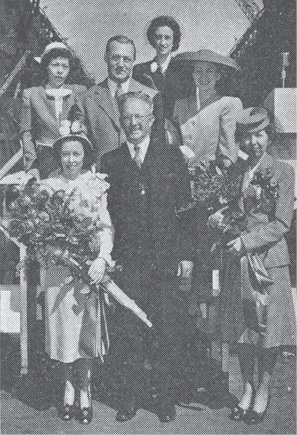 During World War II the U.S. War Shipping Administration commissioned the design of what would become the Victory class of cargo ships. Slightly larger and more powerful than the earlier Liberty ships, Victory ships helped replace losses inflicted by German submarines. Between 1944 and 1946, a total of 531 Victory ships were built—including the SS Vanderbilt Victory. Named in honor of Vanderbilt University, the 455-foot, 10,500-ton ship was launched April 11, 1945.
During World War II the U.S. War Shipping Administration commissioned the design of what would become the Victory class of cargo ships. Slightly larger and more powerful than the earlier Liberty ships, Victory ships helped replace losses inflicted by German submarines. Between 1944 and 1946, a total of 531 Victory ships were built—including the SS Vanderbilt Victory. Named in honor of Vanderbilt University, the 455-foot, 10,500-ton ship was launched April 11, 1945.
Alexander G. Fite, a 1913 Vanderbilt alumnus and associate professor of French at UCLA, represented the university at the ship’s christening and launch by the California Shipbuilding Corp. from the Los Angeles Port of Embarkation in Wilmington. Fite’s account of the ceremony, along with a transcript of his address at the event, was published in the April–May 1945 issue of the Vanderbilt Alumnus, today known as Vanderbilt Magazine.

This was a time when each issue of the magazine was filled with reports from alumni serving as military personnel around the world, usually in a section called “From the Battle Fronts.” In fact, so many alumni were serving in the war that the class notes portion of the magazine was divided into “Military” and “Civilian” sections, and lengthy lists of alumni and students who had perished, were missing in action, or were prisoners of war were meticulously recorded.
As we continue our yearlong celebration of the 100th anniversary of Vanderbilt Magazine—and recognize the 70th anniversary of the end of World War II—we present this condensed version of Alexander Fite’s remarks about the launch of the SS Vanderbilt Victory in 1945.
Fite’s Description of the Ceremony
This has been a very thrilling day, and I am sorry the chancellor could not be here to take part in the launching of the beautiful SS Vanderbilt Victory. All the sons and daughters of Vanderbilt can well be proud to have their Alma Mater’s name carried to the four corners of the earth by such a splendid ship.

The ceremony was very impressive and moved with clock-like efficiency. My address and that of the master of ceremonies had to be timed to the exact second—otherwise the graceful ship would have slid into the water while we were still haranguing the multitude. A very large and enthusiastic crowd was present, although unfortunately not many of our alumni could be there due to the great distances involved. Most of the prominent officials of the mighty California Shipbuilding Corp. were present—some coming all the way from San Francisco and San Diego. The Maritime Commission also was well represented, as well as the Army and Navy, public relations committees and various civic groups. Now all of them know about Vanderbilt.
Yes, the event was indeed a thriller, just like the movies, with real champagne crashing over the bow as the SS Vanderbilt Victory gracefully slid into the water. It was a beautiful and stirring sight. I was very proud of my Alma Mater. My heart beat so fast I almost followed the ship into the water—it was overwhelming, for this achievement represented nothing short of a miracle. Four years ago the very ground itself upon which this mighty shipyard is built was salt-covered marshland, and today the SS Vanderbilt was the 431st ship to slide down its ways.
She’s a beauty: 10,500 tons displacement, 455 feet long, 62 feet beam, and 8,500 horsepower. … The ships built during the last three years by this company alone total more than Japan’s prewar steamship tonnage entire. In 1943 the California Shipbuilding Corp. turned out one ship every 32 hours.
Fite’s Christening Address
This is a great day for my Alma Mater, Vanderbilt University, and I am proud to be able to be here to witness the bestowing of this signal honor. I believe that not only Vanderbilt but the entire South will rejoice because of this day and the launching of this fine ship. All the sons and daughters of Vanderbilt University will thrill at the thought that henceforth a great ship will bear its name upon the distant waters.
This is a great day—another milestone—for this mighty, patriotic, miracle-working, time-annihilating, space-devouring company of builders of ships, which has done so much with so little, and not too late, thank God! The recital of its incredible achievements will still astound future generations even when time marches on at a more dizzying tempo.
This is a great day for our men in the armed services everywhere. For even though the pathway of this ship may be delimited, it will carry continuously to some of them the sight of the flag, thoughts of home, and the things they need. And someday in the not too distant future, it may be its sacred privilege to join in the mighty returning convoy that will be bringing our loved ones back to us once more.

are Vanderbilt alumni Sophie Parsons Clark (Class of 1929), W. Maney Edmondson (Class
of 1921), Margaret Lee Kiely (Class of 1932), and Catherine Craig Langford (Class of 1931).
I am not here to sing the praises of Vanderbilt University, but rather to bring you its greeting from the far South to the Pacific Coast and to offer up a prayer for the safety of those in whose hands the destiny of this boat will be entrusted. Vanderbilt has had a glorious history, and time would fail me to go into details. Vanderbilt itself, like this ship, was born out of war—a war as terrible in its intense way and tragic implications as any we have ever fought—the fratricidal Civil War.
It was at such a time that Commodore Vanderbilt gave the first money to found an institution that would free men’s minds from the shackles of misunderstanding, and help in the slow and painful task of reconstruction. In the intervening years Vanderbilt has labored well, and the generous wishes of its founder have been more than justified. In the three-quarters of a century that it has existed, Vanderbilt has exercised a far-reaching influence; it has sent forth a surprising number of writers, statesmen, lawyers, builders of cities, doctors, scientists and men of God.
Today its war effort is tremendous, and no sacrifice has been too great.
Many of you have heard [for example] of the marvelous and inspiring work done by the various medical units organized and trained in toto at Vanderbilt. It would be a long story indeed to tell you of their work of mercy and salvation stretching well around the globe, of their fearless courage, and of their unwavering labor. This alone would recompense the lofty expectations of the Founder.
POSTSCRIPT
While official information about the SS Vanderbilt Victory’s war service record is limited, one veteran reveals in his diary that the ship was used by the U.S. Navy and Merchant Marine to carry bombs to the South Pacific soon after its 1945 launch. Another veteran records being assigned to the Vanderbilt Victory on July 2, 1945, at Benicia, California, as part of a 28-man gun crew. The ship then set sail for Iwo Jima, where the U.S. was staging its invasion of Japan. In August, after Japan surrendered and the war ended, the Vanderbilt Victory was put into storage.
A few years later the Vanderbilt Victory—along with other Victory ships—was reactivated, refurbished, and sent back into action with Merchant Marine crews during the Korean War, and then again during the Vietnam War.
The ship apparently remained in service at least until Nov. 24, 1967, when area newspapers reported a collision of the Vanderbilt Victory in dense fog at the Martinez, California, waterfront, near the San Francisco Bay. On its way to load munitions for Vietnam, the ship headed off course and hit a fuel dock. As it attempted to back up, the ship was rammed by the SS Columbia, headed upstream with a cargo of scrap metal. The Victory ship suffered a 15-foot gash just below the wheelhouse.
Although newspaper accounts indicated the damage wasn’t considered “serious,” further evidence seems to indicate that the collision—which took place just 400 miles from the site of its launch 22 years earlier—marked the end of the SS Vanderbilt Victory’s service.
The introduction and postscript were written by Associate Editor Phillip B. Tucker.